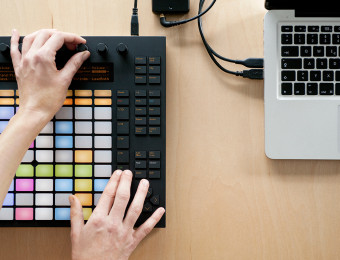We review the Ableton Push, a controller built by and for Ableton that can be used to play, sequence, adjust, and record with Ableton Live 9.
What is Ableton?
Ableton is a company who makes Ableton Live. That is a DAW or Digital Audio Workstation that is an alternative to programs like Garage Band, Logic, Fruity Loops, Cubase, etc. In other words it’s a digital recording studio that lets you create beats, loops, record instruments, mix audio, and literally everything one can do music-wise. Ableton’s big draw is that it has a mode called “session view” that let’s you trigger loops easily… This works well “live”. Ableton is arguably the most popular DAW for playing live.
What is the Ableton Push?
Ableton’s push is Ableton’s answer to why you don’t need a Novation Launchpad or Maschine. That is to say it is a controller that allows you to tweak everything native to Ableton without third party support and that actually makes it one of the first non-third party controllers for any DAW. This is big for those of us who want things to work out of the box.
Using the Drum Pads
So aside from a few select controllers most drum pads include 16 little rubber buttons, or sometimes 32, but very few have had 64. Ableton’s push has 64 nice rubbery pads that will let you play (almost) a full range of sounds like an 88 key piano. That being said, if you are using this as a controller (rather than a digital drum set) you’ll only be using the 16 pads in the lower left corner. No worries though, directly to the left of those pads is a digital slider that you can run your finger up and down to change through banks of sound switching what the 16 pads do (slider seems a little less responsive then the rest of the device). While the pads feel responsive, they aren’t very sensitive so you’ve gotta give them a good “push”. Luckily they are velocity sensitive.
Using the Sequencer
The sequencer is one of the cooler parts of the Push. It works like any other sequencer controller, but has a few perks. One everything you record is recording directly into the session view. That means that you can tweak everything on screen. You can also use quick quantize buttons (and a ton of other controls we will get to) to fix your beat really fast. You can click the sequencer buttons to put a sound down or hit record and play, typically you’ll use both. The metronome is easy enough to control, and this is a common theme, there is very little that isn’t super quick to get to. Sequencers that program into the controller itself have been historically a pain to work with, so having it work hand-in-hand with the DAW is really just awesome. You don’t seem to be able to control time signatures from the Push, but you can control note length and you can simply switch back to the DAW to get an odd time signature in there.
Recording Automation
Aside from all the buttons on the Ableton there are also a ton of knobs. The knobs are responsive and easy to use, the digital display below each knob displays exactly what the knob is controlling at the moment. In fact the digital display is always showing everything. It couldn’t be easier to switch between what the knobs are controlling. You can record automation (opening a filter or turning up the volume) just by hitting the record automation button and then record. That will record it to the loop you are creating, or you can switch over to arrangement view (where you record whole songs rather than loops) and record the automation of one or more full tracks.
Conclusion
Ableton push is a steal for the price. When it comes to producing electronic music very few people are on the same page as to how it should be done and what should be used, but one thing is for sure everything tends to be confusing and come with a steep learning curve. The beauty with Push is that a professional can use it as the backbone of their band live and in the studio, while an amateur can get it working as quick as they can install Ableton Live 9 and plug it in… and at $599 people can actually sort of afford it. For all of these reasons it’s actually one of the smarter buys in creating music… especially electronic music.
Date posted: May 19, 2015








